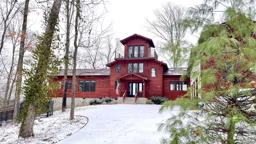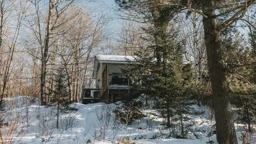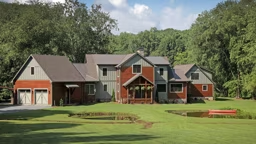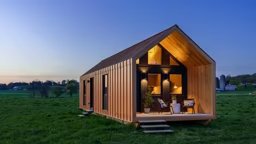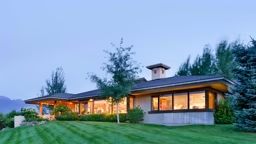Photo: courtesy Mike Walker
High elevation topped the wish list when these Denverites were cabin-hunting in 2013. The place had to have character, too. Both the Walkers cherish memories of summers at vintage cabins: Mike at Mt. Hood in Oregon, and Susan on a lake in northern Wisconsin.
Being off the grid was a must. Since moving from Oregon to Denver in 1995, Mike has shared numerous hiking and skiing trips with buddies. The “tribe” – up to 10 adventurers – stayed at Colorado’s system of backcountry huts. “They’re spectacular,” says Mike, who came to embrace the no-frills, off-grid lifestyle: chopping logs for the wood-burning stove, collecting drinking water, the sense of camaraderie. Even a late-night visit to the outhouse had its perks: the dazzling-white Milky Way above, seen at 11,000-feet elevation with no light pollution.

Paradise Found
In 2014, the couple found the perfect aerie on a five-acre parcel adjacent to Roosevelt National Forest. Built in 1997, the small log cabin – under 700 square feet – is big on rustic charm. With a great room, kitchen, one bedroom and sleeping loft, it accommodates four or five comfortably.The Walkers and two other couples – all longtime friends and hiking companions – went in together on a cash purchase. The three owners use a shared Google calendar to block out days. “Although, we are often there with one of the others anyway,” adds Mike. Recent retirees, he and Susan come up frequently throughout the year. In summer, they relax on the deck and enjoy the aerial acrobatics of hummingbirds at the feeders. Besides hiking, one of Mike’s favorite activities is chopping firewood. “Maybe not fun for most people,” he admits, “but I love the mindless toil and the physical drain.” When the snow flies, they read, play board games, and snowshoe.
That first winter, an antique woodstove in the great room was the sole source of heat. The cabin lacked electricity as well. A pair of 100-pound propane tanks fueled the range and a non-functional wall furnace. From the start, all parties agreed they wanted basic utilities, while keeping the hut-like appeal. “We had learned that it was the absence of amenities that made each trip more special,” Mike notes. “Since we had little to begin with, we decided to fit our improvements to off-grid thinking rather than design to suburban expectations.”

Modest Improvements
Keeping the original 1,500-gallon cistern, they replaced the 45W solar panel that ran the water pump with two 100W, 12-volt panels. Along with six golf cart batteries (there were two originally), the modest array meets everyone’s power requirements without a backup generator or inverter.The owners chose to stick with 12-volt direct current (DC) electricity generated by the panels rather than convert to alternating current (AC). “Our mindset was marine or recreational vehicle,” explains Mike. “Certainly being in sunny Colorado with a broad southern exposure helped, but it was really the emergence of energy-efficient technologies over the past several years that made it possible.”
Lending his expertise as a mechanical engineer to the cause, Mike spent hours searching online for suitable products.
The cabin now boasts LED lights, 12-volt DC power outlets (like car lighter sockets) in all rooms, a car stereo for music, a 12-volt DC refrigerator. A propane tankless water heater and a new high-altitude propane furnace are both battery-operated.
Steps lead from the cabin to the outhouse; the goal this year is to replace the old hand-built commode with an RV toilet and add running water, sink and shower. Mike also plans to create a rainwater catchment system to replenish the cistern, instead of toting 55-gallon drums of water from home.
“That is one thing I love about the cabin – everything was done by hand before we bought it, and we’ve done everything since by ourselves as well,” says Mike. “It’s been a fun learning experience.”
From the Owner: Essentials for Off-Grid Cabin Living
Cabin owner Michael J Walker's complete list of off-grid products:
Dear readers,
Below are links to all of the products that we have purchased relative to our off-the-grid needs for our cabin in the Rockies. There is a lot here and much more than I expect you will use, but I thought I’d be comprehensive and you can decide what you think is worthwhile. When there was a manufacturer’s website I’ve listed that, but many things are obscure and were just purchased from amazon.com.
We spent about $4,800 in 2015 which was for everything – including all improvements, furniture, taxes, insurance, propane, etc. So, this is not an expensive operation.
A note about relying on 12-volt DC for power
It is only reasonable to do this when you have a situation where (1) You have short distances to cover – that is you have a small footprint cabin, (2) Your loads are low.
Except for the fridge and water pump, our circuits are below 5 amps all the time. That means we will never have a microwave, garbage disposal or dishwasher, but then again we didn’t want those things. When we want to use power tools or a vacuum cleaner, we use the generator.
We have a single 110-volt AC outlet in the cabin that runs to the generator, but we very rarely use it. If you start with 12-volt DC thinking and a boat/RV mindset, and know what you’re getting into, it is a completely viable approach that will keep your costs low. It is not a way to duplicate on-grid living.
About our generator
It runs on gas only, has manual start and can put out 3,300 watts. We spotted a DuroMax XP4850EH Hybrid Portable Dual Fuel Propane/Gas Camping RV generator on sale $325, close to the same price we paid for our model. But the DuroMax is dual fuel (gas and propane) and electric-start. If we had that model, we could pull the wheels off and make a permanent installation. We’d wire an interior wall switch start in parallel with a low-voltage start running to the battery bank. I think we will still likely do that someday, but right now we really don’t need it so it isn’t a priority.
Appliances
- 12-volt DC refrigerator – The manufacturer is Grape Solar. You can view the model we bought on Home Depot’s website, homedepot.com. Grape Solar is a small company out of Eugene, Ore., that imports the basic fridge from China and then improves it for the North American market.
- Propane tankless water heater – Visit aquahstore.com/catalog. This one is sized right for us (3 GPM). The usual brands (Rheem, etc) are far more expensive and are sized for a suburban home. Some of these Aquah models only need a pair of D-cell batteries to ignite.
- Propane Furnace – Go to williamscomfortprod.com. We had to special order the propane version suitable for 8,000-feet elevation. The furnace does not require any electricity – the millivolt gas valve is powered by temperature and the thermostat uses a pair of AAA batteries. So it heats by convection only – no fan required.
- RV toilet – To see the model we are buying, visit dometic.com. The trick here will be having a good draining method for the cold months.
- 12V ceiling fan – We will buy one to help distribute the heat evenly: altestore.com. It only pulls 4 watts at 102 RPM.
- Shower – We will likely use this for our shower: amazon.com.
Solar & electrical
- Solar charge controller – See morningstarcorp.com. This is a PWM model that is both a charge controller and a load manager. PWM is a good technology when you only use your system periodically (use on weekends, recharge on weekdays), as it is better at extending battery life than a MPPT controller. Although MPPT is more efficient (and more expensive), the advantages of MPPT are minute on small scale systems like ours.
- DC power meter – We have two to measure solar produced and load: see on Amazon here.
- Solar panels – See them at renogy.com. (We bought them on Amazon.com.)
- Golf cart batteries – See them at samsclub.com.
- Choosing batteries is controversial – many people have the “you get what you pay for” perspective that says you should order Trojan or Interstate batteries that are much more expensive, but will probably last longer. Our perspective is that often the same product is sold under different brands and you are paying for the brand more than the product. Or, in some cases, you pay double for something that will last only 25% longer. In a few years, we’ll find out if we were right.
- Stranded wire used in DC systems - We used a mix of stranded and Romex – the Romex is much cheaper for outdoor use than marine quality stranded.?A good option for lower amperage circuits is low voltage landscape wiring. You can find that in 12-gauge wire and it is stranded and intended for outdoor use.
- Protecting electronics from inductive loads – We use a bi-directional diode across our water pump to protect the load controller. The fridge bypasses the load controller completely.
- Voltage drop calculator – This is used for sizing DC wire gauge: calculator.net.
- Relay used to load manage the current to our fridge – See amazon.com. We used this because we did not want the fridge load going through the load controller. The load is high current and inductive, but we wanted to take advantage of the load controller’s low-voltage cutoff at 11.7 volts (which protects the batteries) and have a single main breaker for the entire cabin.?So we wired the fridge through this relay directly to the batteries, but the relay is controlled by the load manager and the load manager is switched at the breakers.
- 12-volt DC power outlets – See amazon.com. These are mounted vertically around the cabin.
- 5.6-watt 12-volt LED bulbs with conventional E26 bases – See amazon.com. We used these when repurposing old lamps:
- 9-watt 12-volt LED bulb with E26 base – Go to smile.amazon.com. These are brighter bulbs for our pole lamps.
- MR16 sockets for building your own pendant and chandelier lights – See amazon.com.
- 12-volt power plugs used to retrofit conventional lamps – Visit amazon.com.
- Pantry door light switch control – Visit smile.amazon.com. We kept leaving the pantry closet light on accidentally, so we wired it to a magnetic door switch so it would come on automatically when opened – like a refrigerator light. Having a low voltage system meant we didn’t have to use a separate relay.
- 2-watt LED dome light used in outhouse, pantry and crawl space – Go to smile.amazon.com. This light is really bright, very inexpensive and is perfect for any place where aesthetics aren’t important (the light is fairly cold).
Water system
- Rainwater harvesting parts – Check out rainharvest.com/shop. It’s the most extensive U.S. online catalog that I’ve found.
- Links to permits for the State of Colorado – Find them at water.state.co.us.
- Water pump – Go to eccotemp.com.
- 12-volt DC UV sterilizer – See viqua.com. We have gone back and forth on UV sterilization versus ozonation, but right now are in the UV camp.
Cellular Internet
Without an amplifier we get sporadic cell service, one bar that would come and go.
- Cellular amplifiers and antennas – Check out www.weboost.com. Ours is cabled to this antenna: store.weboost.com/products/301111. We put one of our phones in the cradle and then use the phone to provide WiFi for the cabin. The cradle is intended for in-car use and so is a 12-volt product with an automotive style power plug.
- To point our antenna, we used a combination of Android apps (“CDMA Field Test,” “LTE Discoverer”), to log data, Google Earth to determine angles to cell towers, and Microsoft Excel to analyze the data and determine what tower would be best. The antenna is specific to the carrier and the technology. For us that means a Verizon tower on Fort Collins High School (Colorado) about 16 miles away as the crow flies. Of course you can sign up for satellite Internet and some locations have line-of-sight Internet, but then you are paying a monthly cost for sporadic use and typically bandwidth is low.
- Also, the satellite Internet boxes use more power than we wanted to burn – the amplifier above uses less than 10 watts of power where satellite is typically 40-70 watts.
I hope this information is helpful. Best regards, Mike Walker



